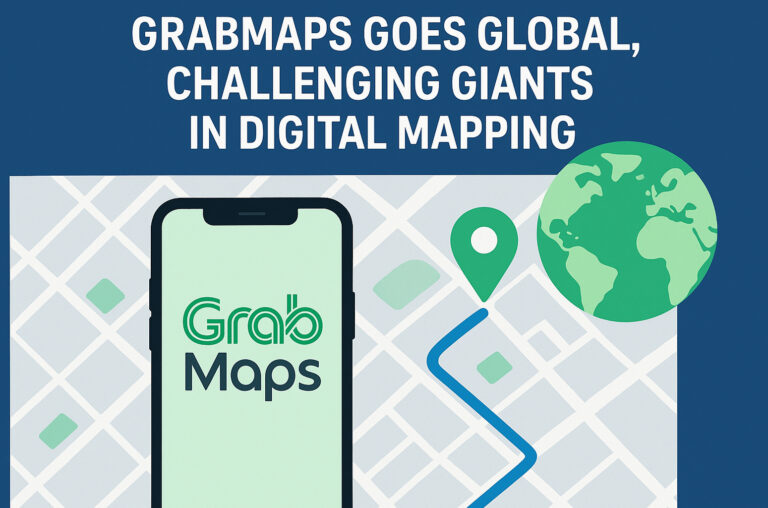Premium Biz Post – Southeast Asia’s leading super app, Grab, has taken a bold step. It is moving beyond its traditional ride-hailing and delivery services. Grab is expanding GrabMaps to the global market. This move into the digital mapping arena signals its ambition to compete with established industry giants. Grab is transforming its in-house navigation tool into a revenue-generating product.

GrabMaps: From Internal Tool to Global Technology Platform
GrabMaps was originally developed as an internal solution. The goal was to improve accuracy and efficiency in Grab’s ride-hailing and delivery operations. It was tailored to the complex and dynamic road networks across Southeast Asia. Over time, it evolved into a sophisticated mapping platform. It is now capable of handling intricate logistics, real-time updates, and localized data with impressive precision.
Grab’s transition to offering GrabMaps externally represents a strategic shift. By commercializing its mapping technology, the company aims to diversify its business model. It also seeks to establish a new digital revenue stream. The technology is already being used in markets outside Southeast Asia. Mongolia serves as the first international testing ground.
This expansion underscores Grab’s confidence in its data-driven infrastructure. It shows its readiness to enter a market traditionally dominated by global tech leaders. Examples include Google, Apple, and HERE Technologies.
Read More : ”Helping Nature Become Jade The Natural Process and Its Philosophical Values”
Why Mapping Technology Matters in the Digital Economy
Accurate mapping is the backbone of countless digital services today. These services range from ride-hailing and delivery platforms to logistics, tourism, and urban planning. As smart cities and autonomous vehicles evolve, the demand for real-time, hyperlocal mapping data has never been greater.
Grab recognized this opportunity early. The company has amassed extensive datasets from years of operational experience. This experience comes from one of the most geographically diverse regions in the world. The data covers everything from narrow alleyways to newly built highways. This deep localization gives GrabMaps a competitive edge. It is especially useful in areas where Western mapping tools often lack precision.
According to Grab’s technology team, their system refreshes location data up to every five minutes. This ensures accuracy, even in high-density urban zones. The platform integrates data from driver movements, user reports, and AI-driven analysis. This creates an ever-evolving map that reflects real-world changes almost instantly.
The Road to Global Expansion
Grab’s decision to expand GrabMaps was not spontaneous. The groundwork was laid through years of internal testing, optimization, and partnerships with regional governments. The successful deployment in Mongolia marks the first phase of the global rollout. It focuses on regions where existing mapping coverage is limited or outdated.
The company plans to target countries with emerging digital economies. It also targets rapidly growing transportation sectors. These regions could benefit most from precise, localized mapping solutions. Grab is positioning itself as a data infrastructure provider. The company aims to replicate its Southeast Asian success on a broader scale.
Grab has also started exploring collaborations with logistics firms and mobility startups. It is even partnering with public sector agencies. These parties are interested in leveraging its mapping API for various applications. Examples include traffic optimization, route analytics, and smart city initiatives.
Competing with Global Tech Giants
Entering the global mapping market means stepping into a space dominated by a few powerful incumbents. These include Google Maps, Apple Maps, and HERE Technologies. These companies have decades of experience and extensive global coverage. However, Grab believes its regional expertise, AI-powered mapping engine, and on-the-ground data collection offer distinct advantages.
One of Grab’s biggest differentiators lies in its real-world user base. Millions of Grab drivers, riders, and delivery partners generate vast streams of geospatial data daily. This data not only fuels GrabMaps’ accuracy. It also allows for real-time insights into traffic patterns, road closures, and navigation inefficiencies.
Google Maps relies heavily on satellite imagery and third-party data. In contrast, GrabMaps is built on firsthand, human-driven input from active transport networks. This makes it particularly adaptable for emerging markets. In these markets, infrastructure development is rapid, and traditional mapping tools often lag behind.
Technology at the Core of GrabMaps
GrabMaps leverages machine learning and AI-based spatial modeling. It processes and interprets massive datasets. The system employs automated feature recognition to detect new roads, landmarks, and changes in geography. This is done using a mix of visual data and telemetry from vehicles.
The platform is also optimized for integration. Developers and businesses can access GrabMaps through APIs. This enables them to build navigation, logistics, and geolocation-based services without relying on foreign providers.
Grab’s engineering team emphasizes that this “map-as-a-service” approach ensures flexibility, scalability, and customization. GrabMaps offers a more adaptable solution in countries where localization is key. This is true for nations with multiple languages or complex address systems.
Economic and Strategic Implications for Grab
Diversifying into digital mapping offers multiple strategic benefits. First, it opens a new revenue stream beyond Grab’s traditional mobility and delivery operations. Second, it strengthens the company’s technology brand. It positions Grab not just as a super app, but as a regional tech innovator capable of exporting digital infrastructure solutions.
Industry analysts suggest that Grab’s move could inspire other Southeast Asian tech firms to follow suit. This signals the region’s growing confidence in producing globally competitive technology. Furthermore, the monetization of GrabMaps aligns with Grab’s broader push toward profitability. This follows years of rapid expansion and intense competition in ride-hailing.
The company’s CEO, Anthony Tan, previously hinted at the importance of “building Southeast Asia’s next generation of digital infrastructure.” GrabMaps is arguably the most concrete manifestation of that vision to date.
Challenges Ahead
Despite its ambitious plans, Grab faces significant challenges in scaling GrabMaps globally. Competing with entrenched players like Google requires immense investment in satellite data, infrastructure, and partnerships. Moreover, entering new markets often involves regulatory hurdles, data privacy concerns, and the need for localized updates.
Another challenge lies in consumer perception. For millions of users worldwide, “Google Maps” is synonymous with navigation. Convincing developers and businesses to adopt GrabMaps will require competitive pricing and demonstrable accuracy and reliability.
Grab must also ensure that its rapid expansion does not compromise data security. This is especially important given the increasing scrutiny around how tech companies collect and store location data.
The Future of GrabMaps
Looking ahead, Grab envisions GrabMaps as a platform-as-a-service (PaaS) offering for a wide range of industries. Beyond mobility, the technology can be applied to logistics management, urban planning, public transportation optimization, and even environmental monitoring.
The company also plans to integrate augmented reality (AR) features, voice navigation, and predictive traffic modeling powered by AI. This will enhance user experience. These innovations could position GrabMaps as a strong alternative in markets where local relevance and customization outweigh global dominance.
Furthermore, Grab’s expansion into new territories like Mongolia is just the beginning. The company has hinted at entering other emerging regions in Central Asia, Africa, and the Middle East. These areas are ripe for digital infrastructure investment.
Grab’s expansion of GrabMaps into the global market represents a pivotal moment in its evolution. It is transforming from a regional super app to a global technology player. By turning its internal mapping tool into a commercial platform, Grab signals a clear intent: to challenge the established order in digital mapping. It also asserts Southeast Asia’s growing influence in global tech innovation.
As GrabMaps gains traction outside Southeast Asia, the coming years will reveal whether the company can truly compete on the world stage. They will also show if its homegrown, data-driven approach can redefine the future of digital mapping.



